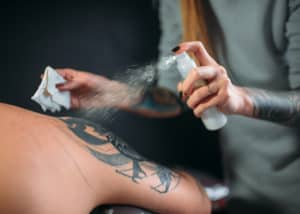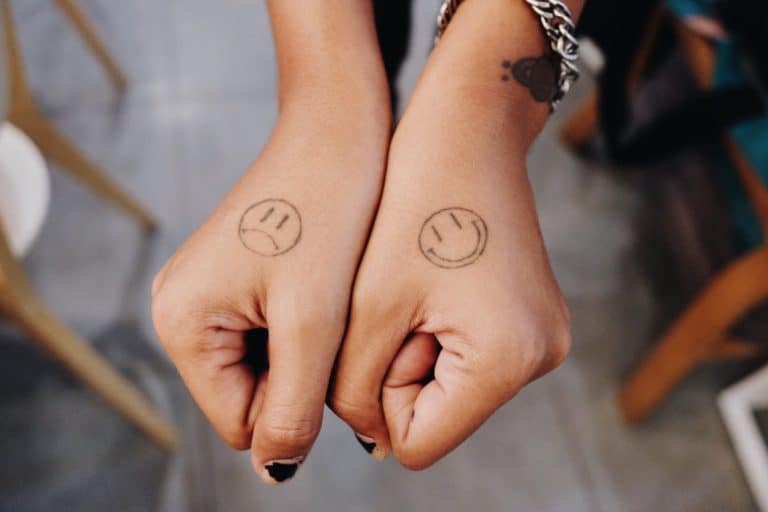If you are considering getting a new tattoo then there are some things you will need to do when it comes to proper tattoo aftercare to make sure that it does not become infected. While most tattoos do not get infected, there are a few things that can result in a tattoo infection.
This article will provide you with information as to how a tattoo can become infected, and how you can prevent an infection of your new tattoo. There are several key indicators that a tattoo has become infected.
Before we discuss these symptoms, let’s first talk about what tattoos really are, and how an infection might occur. Let’s dig in.
An Inked Scar
No matter what a tattoo looks like, they are all a form of scaring. As the tattoo gun hums back at forth, its needle point drills into your skin. This causes scarring, and as the blood comes out, the ink goes in.
So, essentially the process of tattoo, or “getting inked,” is the process of making a small cut into your skin with a needle, and filling in the wound with permanent ink. Understanding 
As a tattoo is a wound, it makes sense that anything that will touch this wound needs to be sterile, meaning free of any harmful bacteria. Therefore, any equipment, such as a tattoo gun, or ink, that has either not been properly cleaned, or has been contaminated with dirty water, can cause a tattoo to become infected.
However, assuming you get your tattoo at a reputable, and more importantly, licensed tattoo parlor, you should be fine. Tattoo ink can also become contaminated if it is stored improperly, or if it becomes diluted with dirty water.
As the needle on the tattoo gun is actually injecting small drops of ink into your skin, if either the needle, or the ink become contaminated, it can cause an infection in the wound.
How to properly store and sterilize tattoo equipment is a big part of becoming a licensed tattoo parlor. Most tattoo shops will display their licensing certifications out front, so it should be quite easy to tell if the shop is licensed. That being said, if you do not see any licenses displayed, make sure to ask the owner to show you their license.
Generally speaking, if a tattoo shop does not display their license out front and center, you should probably go elsewhere for your new ink.
Sometimes, a tattoo party is held as a private event in someone’s home. While these may be fun and interesting events, it is not advised that you actually get a tattoo at a party like this, as the environment is most likely not sterile, and the equipment runs a higher risk of being contaminated.
Symptoms of an Infected Tattoo
Okay, now that you know that a tattoo is a wound, and how this wound could become infected, we should now discuss what to look for as far as a tattoo infection.
The most common type of tattoo infections are skin irritations such as a rash, or redness around the new tattoo. These can be treated with over the counter allergy medications such as benadryl.
An infected tattoo can sometimes cause a fever if bad enough. This can be cured with some tylenol. However, you have a fever for more than 48 hours, or if your symptoms worsen into a more severe fever, or if you have a sudden increase in pain around the tattoo, then you should seek medical treatment.
Another common symptom of a tattoo infection is perculant drainage. This can look like a milky colored liquid that will ooze from the tattoo. Often this will come out during the tattoo process. So, a little bit during the tattoo healing process is not uncommon.
However, if the drainage is brown or greenish in color, you should seek immediate medical attention as this can be an indicator that you have a staph infection.
As you might be gathering so far, a tattoo infection can vary in how severe it is. Sometimes, it is a small, and somewhat common infection that can be cured with simple remedies. However, sometimes the infection can be quite severe, and require medical attention.
As soon as symptoms worsen, or if they are severe and seemingly unusual from the start, then you should seek medical assistance. Failure to act in time can cause the infection to spread, and that can be quite painful, dangerous, and costly.
It is also not advised for you to get inked within six weeks of being ill. When you are sick, your immune system becomes weakened. A weakened immune system at the time of getting a new tattoo can potentially lead to an infection that might not have occurred, or occur as strongly, then it would if your immune system is healthy.
Six weeks is a good measure of time after you have been sick as that is enough time for your immune system to fully recover.
Infected Tattoos
Here are a few stats that might give you a better idea of how likely it is that your tattoo will become infected. These will also hopefully help to put your mind at ease in the process.
A survey done in 2017 found that 40% of persons in the US, between the ages of 18 and 64 have at least one tattoo. 25% of this inked population has several tattoos. Another study in 2016 discovered that no more than 6% of all tattoos become infected, and in some instances – meaning legal, licensed, and safe tattoos – that number is as low as 0.5%.
So if you are looking at getting your first tattoo, then you should find a reputable shop that both proudly displays their work, as well as licenses and certifications that prove they are legit. If you do that, then your chances of getting a tattoo infection are quite low.
It is also important to note that tattoos can become infected years in the future, however, it is uncommon. This can look like worsening of a pre-existing skin condition like eggesma, or a rash. You should also know that an infected tattoo does not mean that it is ruined.
You may have to get it touched up a bit depending on which areas the tattoo has infected, but generally speaking the tattoo should remain tact. Tattoos naturally fade overtime, so the touch up process is normal regardless if it was infected or not.
How to Properly Care for a New Tattoo
Once you have received your new tattoo, it is important to immediately begin proper after care. This includes keeping it covered for at least a week. It is recommended that you change the gauze 
It is a good idea to have some anti-inflammatory, and hypoallergenic topical creams on hand in case your tattoo area becomes irritated. There are also various tattoo specific topic creams that are designed specifically for tattoo aftercare.
You may also like to try the completely natural aftercare process of air-dying, meaning no topical treatments of any kind, and just simple bandaging. While this way can be painful, it can also help to preserve the new ink as much as possible.
There is no set way to heal and care for a new tattoo. As long as you follow the general tattoo after guidelines as far as keeping it covered, and washing it will be antibacterial, and odor-free soaps, you will greatly reduce the chance of an infection. So, whichever method you chose to use is in entirely up to you.
Just make sure you keep a close eye on the tattooed area for any signs of a potential infection. If you notice a possible infection, and it persists or worsens for more than 48 hours, seek immediate medical attention.
Will an Infection Ruin My Tattoo?
It’s highly unlikely that your tattoo will be ruined from an infection. Depending on the type of infection and how bad it gets, there is the possibility that you will have to revisit your tattoo shop to have it touched up.
This is more common when the infection area leaks and some of the ink from the tattoo drains. Getting a tattoo touched up isn’t a difficult process. It’s actually very common.
One thing to keep in mind is that you won’t be able to get it touched up until your infection is completely healed. The length of time for an infection to heal can vary significantly from person to person.
How Can You Tell if a Tattoo Is Infected or Just Healing?
As we discussed above, there are some obvious warning signs that can indicate if your new tattoo is infected.
Here’s a list of the most common symptoms to indicate you have an infection:
- Tired or not feeling well since getting the tattoo
- Fever
- Discharge from the tattoo that smells or has a brown, green or yellow color
- Significant swelling around the tatoo
Can you Put Peroxide On An Infected Tattoo?
Peroxide is often used on cuts and scraps to help with the healing process. Peroxide kills most viruses and bacteria, therefore it’s easy to assume that it would be effect in healing an infected tattoo. This is incorrect! You should not apply peroxide to your tattoo. Doing so could damage your tattoo. In fact, many “natural tattoo removal” remedies include using peroxide. Due to these reasons, I highly suggest NOT applying peroxide to an infected tattoo.
Can An Infected Tattoo Heal on it’s Own?
Yes, if the infection is very minor. However, it’s best to be cautious when dealing with an infection to ensure it doesn’t get worse. The severity of an infection can increase quickly. This can but both your health and your tattoo at risk.
Can I Clean My Tattoo With Salt Water?
While it is generally recommended not to go swimming in the ocean after getting a tattoo, a saltwater saline solution mix can be beneficial to the healing process of an infected tattoo.
It’s easy to create a saltwater saline with normal household products. To create the solution, simply mix about 1/4 of a teaspoon of salt or sea salt with 8 ounces of distilled water. Make sure the water you are using is distilled and not normal tap water. Distilled water is much cleaner than regular tap water.
Once you’ve mixed the water and salt, simply apply a small amount of the salt water saline to your tattoo 4-5 times per day to help with the infection.

